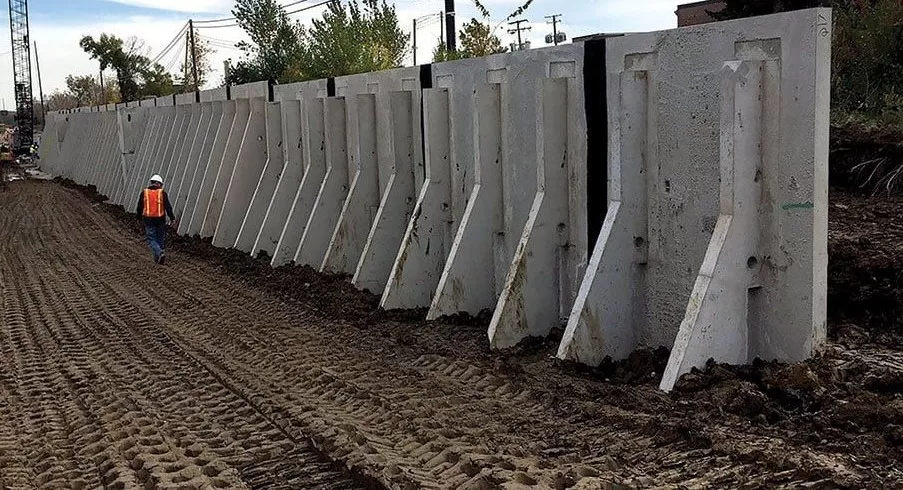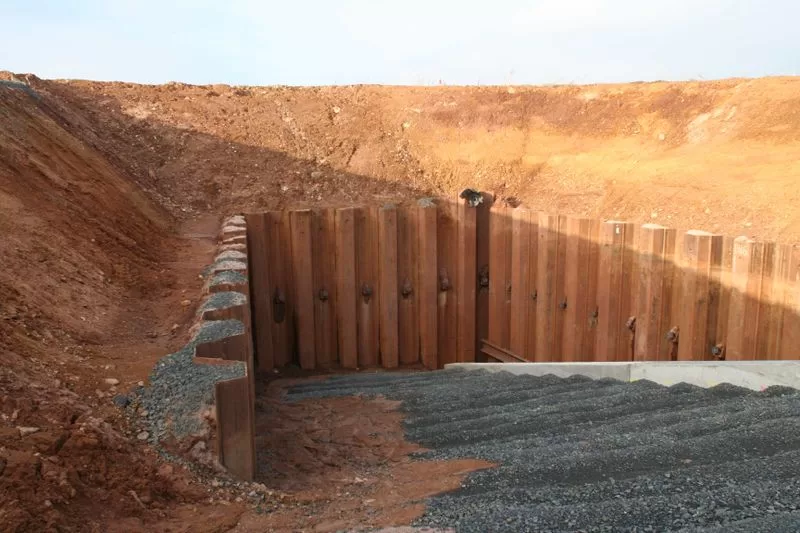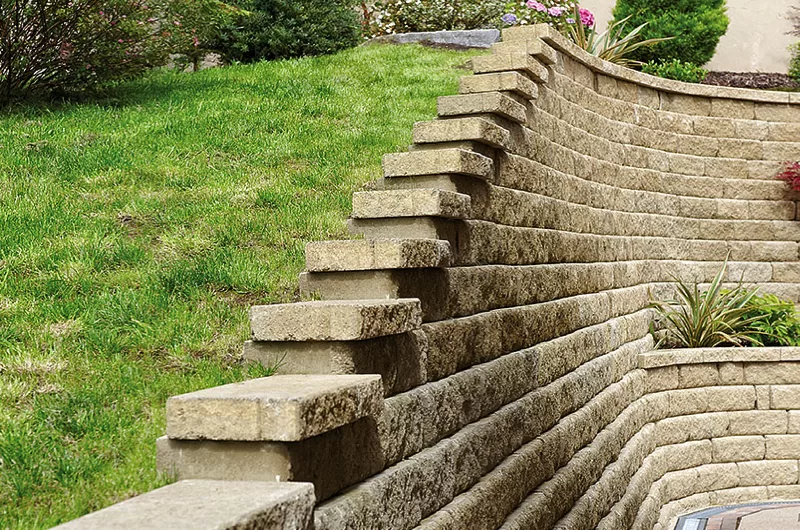A retaining wall is a purpose-built structure intended to withstand the sideways pressure exerted by soil, especially when there’s a planned alteration in ground height that surpasses the soil’s natural angle of repose. These walls are employed to provide lateral support to soil, allowing it to be held at differing levels on opposite sides. Designed for the purpose of confining soil within a gradient it wouldn’t naturally maintain-typically a steep, almost vertical, or entirely vertical incline-retaining walls find use in scenarios where land features undesirable slopes. They’re also essential in areas where land contours require significant modification and engineering to serve specific objectives, such as terraced agriculture or the construction of road overpasses.
Factors to be taken into account during the design of a retaining wall
Retaining walls encompass vertical or nearly vertical structures meticulously crafted to secure substances on one side, averting collapse, slippage, or erosion. They offer stability to landscapes where the soil’s natural angle of repose is surpassed, preserving it from morphing into a more instinctive configuration. The pivotal attribute of a retaining wall lies in its capacity to withstand the force exerted by the contained material, which is often soil.
Paramount in the proper design and installation of retaining walls is the acknowledgement and mitigation of the proclivity of retained materials to migrate downslope due to gravitational forces. This engenders lateral earth pressure behind the wall, influenced by the angle of internal friction (phi) and the cohesive strength (c) of the retained material. Also influential are the direction and magnitude of the movements undergone by the retaining structure.
The lateral earth pressures commence at zero atop the wall and—within uniform terrain—escalate proportionally, culminating at its nadir. These pressures can prompt the wall to thrust forward or topple if not effectively managed. Furthermore, any subterranean water retained behind the wall, unvented by a drainage system, exerts hydrostatic pressure on the wall. The cumulative force or thrust is commonly considered to operate at a point one-third of the way from the bottom for uniformly tall stretches.
Implementing proper drainage behind the wall is indispensable to confine the pressure within the wall’s design limits. Drainage components work to alleviate or nullify the hydrostatic pressure, augmenting the stability of the material behind the wall. Drystone retaining walls, for instance, tend to be intrinsically self-draining. Notably, the International Building Code mandates that retaining walls must be engineered to ensure resistance against overturning, excessive foundation pressure, sliding, and water-induced uplift. Furthermore, they must be designed with a safety factor of 1.5 against lateral sliding and overturning.
Types of retaining walls
Gravity Retaining Walls:
Gravity walls rely on their substantial weight to counteract the pressure of the soil or material they are retaining. They are often made using dense materials such as concrete or stone. The weight of the wall provides stability and prevents the retained material from pushing the wall forward. These walls are suitable for relatively low heights and where aesthetics are important.

Cantilever Retaining Walls:
Cantilever walls use a horizontal base slab and a projecting arm, or cantilever, to resist the soil pressure. The base slab and cantilever arm work together to balance the forces exerted by the retained material. These walls are commonly made from reinforced concrete, and their design includes careful consideration of structural integrity and stability.

Counterfort Retaining Walls:
Counterfort walls are an extension of the cantilever design, but they include vertical concrete supports called counterforts on the backside of the wall. These counterforts provide additional reinforcement and distribute the lateral forces more effectively. Counterfort walls are used for taller retaining structures where the cantilever design alone might be insufficient.

Sheet Pile Retaining Walls:
Sheet pile walls consist of thin, interlocking sheets made from materials like steel, vinyl, or wood. These sheets are driven into the ground to create a barrier against soil or water pressure. Sheet pile walls are often used in areas with limited space, such as urban environments, and where the soil is relatively soft and easy to penetrate.

Anchored Retaining Walls:
Anchored walls use cables or rods that are anchored into the soil or rock behind the wall. These anchors provide additional lateral support and prevent the wall from overturning or sliding. The cables are tensioned and secured to the wall, creating a stabilizing force that counters the pressure from the retained material. Anchored walls can be used in various types of soil and are particularly useful for taller walls.

Gabion Retaining Walls:
Gabion walls are constructed by filling wire mesh baskets (gabions) with rocks or other materials. These walls are flexible and allow water to pass through, which makes them suitable for areas prone to erosion. Gabion walls are often used in landscaping projects, along roadways, and for shoreline protection.

Tied-Back Retaining Walls:
Tied-back walls utilize anchors or cables that are attached to the wall and extend into the ground behind it. The cables are anchored to a stable structure, such as a concrete deadman, to provide additional support. Tied-back walls are often used in scenarios where the retained material exerts significant pressure and requires an efficient counterforce.

Segmental Retaining Walls:
These walls consist of individual concrete blocks or units that are stacked to create a wall structure. They can be dry-stacked or use interlocking mechanisms. Segmental retaining walls are versatile, easy to install, and can be used for both small garden walls and larger structures. They often have a more aesthetic appearance compared to some other types of walls.

Reinforced Soil Retaining Walls:
These walls blend soil with reinforcement materials like geogrids or geotextiles. The reinforcement enhances the strength of the soil and allows for the construction of taller and steeper walls. These walls are cost-effective and environmentally friendly, as they use less concrete and can be vegetated for a more natural look.

Hybrid Systems:
In some cases, engineers opt for hybrid retaining wall systems that combine the benefits of different techniques. For instance, a wall could integrate aspects of anchored, cantilever, and gravity designs to address specific challenges of the site.
Conclusion
Retaining walls serve as vital engineering solutions for managing the complex dynamics of soil and terrain. These structures are carefully designed to counteract the lateral pressures of soil, preventing collapse, erosion, and undesirable alterations in ground elevation. From the dependable weight of gravity walls to the strategic balance of cantilever and counterfort designs, each type of retaining wall offers a unique approach to stability and support.
Sheet pile and anchored walls address the challenges posed by limited space and intense soil pressures, respectively. Gabion walls showcase adaptability by blending functionality with aesthetics, especially in landscaping projects. The modular versatility of segmental walls caters to various scales of construction, while reinforced soil walls combine innovation with sustainability.
Moreover, the evolution of retaining wall engineering has led to the emergence of hybrid systems that amalgamate different strategies to effectively tackle site-specific complexities. Throughout this diverse spectrum, the common thread remains: the paramount importance of understanding soil behavior, structural dynamics, and the interplay of forces.
In the pursuit of safe and efficient construction, choosing the appropriate type of retaining wall is a harmonious fusion of science, design, and pragmatism. By considering the unique conditions of each project, retaining walls stand as resilient sentinels, not only preserving landscapes but also shaping the foundation of a more secure and sustainable built environment.





